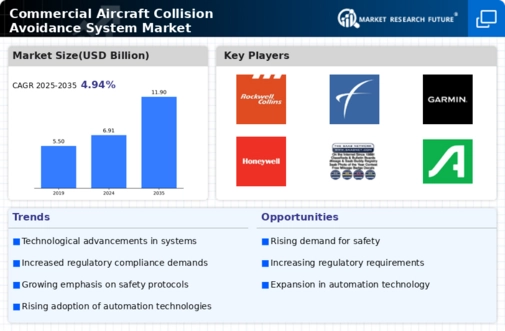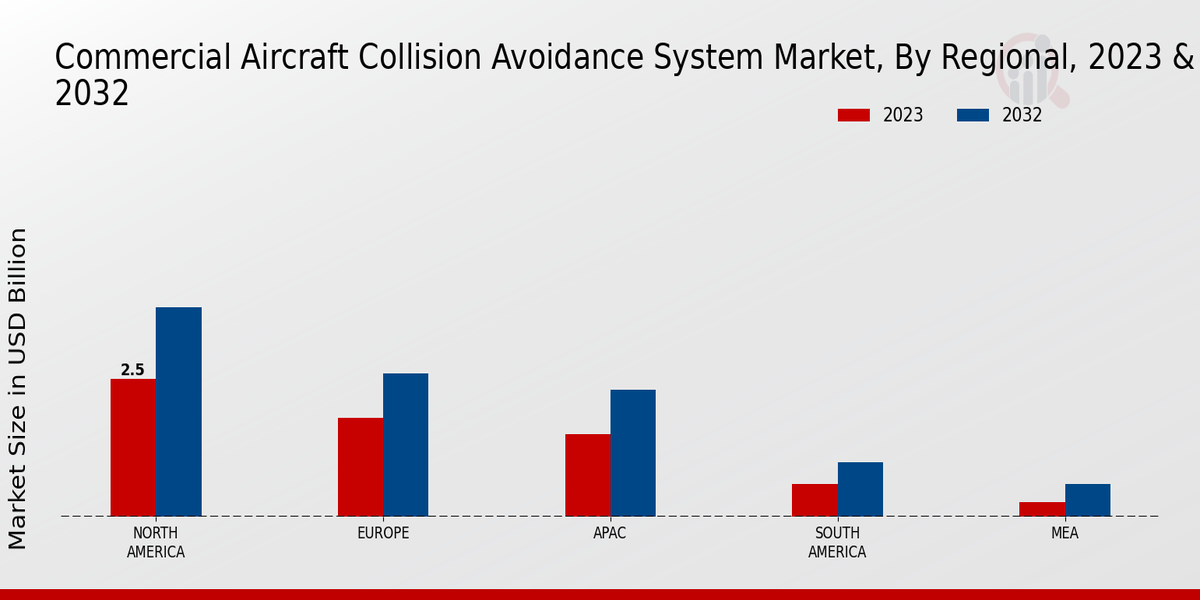Regulatory Compliance
Stringent regulatory requirements imposed by aviation authorities worldwide are a crucial driver for the Global Commercial Aircraft Collision Avoidance System Market Industry. Organizations such as the Federal Aviation Administration (FAA) and the European Union Aviation Safety Agency (EASA) mandate the implementation of advanced collision avoidance systems to ensure passenger safety. Compliance with these regulations is essential for airlines to maintain operational licenses and avoid penalties. As regulations evolve, the demand for upgraded systems is likely to increase, contributing to a projected market growth to 11.9 USD Billion by 2035. This regulatory landscape fosters innovation and investment in collision avoidance technologies.
Increasing Air Traffic
The continuous rise in global air traffic is a significant factor influencing the Global Commercial Aircraft Collision Avoidance System Market Industry. With the International Air Transport Association (IATA) forecasting a doubling of air traffic by 2035, the need for effective collision avoidance systems becomes increasingly critical. As more aircraft occupy the skies, the risk of mid-air collisions escalates, necessitating advanced safety measures. This growing demand is expected to drive the market to an estimated value of 11.9 USD Billion by 2035, with a compound annual growth rate (CAGR) of 5.07% from 2025 to 2035. Airlines are thus compelled to invest in advanced collision avoidance technologies to ensure safety.
Focus on Aviation Safety
A heightened focus on aviation safety among airlines and regulatory bodies is a pivotal driver for the Global Commercial Aircraft Collision Avoidance System Market Industry. Recent incidents have underscored the importance of robust safety measures, prompting airlines to prioritize investments in collision avoidance systems. This emphasis on safety is reflected in increased budgets allocated for technology upgrades and training programs. As airlines strive to enhance their safety records, the market is projected to grow significantly, reaching 6.91 USD Billion in 2024. This trend indicates a shift towards proactive safety measures, fostering a culture of safety within the aviation industry.
Market Growth Projections
The Global Commercial Aircraft Collision Avoidance System Market Industry is on a trajectory of growth, with projections indicating a market size of 6.91 USD Billion in 2024 and an anticipated rise to 11.9 USD Billion by 2035. This growth reflects a compound annual growth rate (CAGR) of 5.07% from 2025 to 2035, driven by factors such as technological advancements, regulatory compliance, and increasing air traffic. The market's expansion is indicative of the aviation industry's commitment to enhancing safety and operational efficiency through innovative collision avoidance solutions.
Technological Advancements
The Global Commercial Aircraft Collision Avoidance System Market Industry is propelled by rapid technological advancements in avionics and sensor technologies. Innovations such as enhanced radar systems, GPS integration, and artificial intelligence are improving the accuracy and reliability of collision avoidance systems. For instance, the introduction of Automatic Dependent Surveillance-Broadcast (ADS-B) technology has significantly enhanced situational awareness for pilots. As a result, the market is projected to reach 6.91 USD Billion in 2024, reflecting the growing demand for sophisticated safety systems in commercial aviation. These advancements not only enhance safety but also contribute to operational efficiency, thereby driving market growth.
Emerging Markets and Regional Growth
Emerging markets are playing an increasingly vital role in the Global Commercial Aircraft Collision Avoidance System Market Industry. Regions such as Asia-Pacific and Latin America are witnessing rapid growth in air travel, leading to a surge in demand for advanced collision avoidance systems. As airlines in these regions expand their fleets and modernize their aircraft, the need for state-of-the-art safety technologies becomes paramount. This trend is expected to contribute to a market valuation of 11.9 USD Billion by 2035, driven by the increasing focus on safety and regulatory compliance in these burgeoning markets.





















Leave a Comment